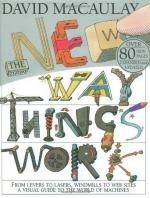
|
| Name: _________________________ | Period: ___________________ |
This test consists of 15 multiple choice questions and 5 short answer questions.
Multiple Choice Questions
1. What is the action of something burning?
(a) Molecular deceleration.
(b) Convection.
(c) Combustion.
(d) Radiation.
2. What does the inclined plane do?
(a) Decreases effort.
(b) Extends the distance to a rise.
(c) Increases effort.
(d) Decreases gravitational force.
3. What is a substance that contains only one type of atom?
(a) A cell.
(b) A molecule.
(c) A quantum.
(d) An element.
4. How does a wedge move an object up an inclined plane?
(a) It forces the object to reduce the effects of gravity.
(b) It uses the effect of gravity.
(c) It lowers the plane so the object slides.
(d) It doesn't ; the wedge moves the plane itself to raise an object.
5. What are the effects of electricity?
(a) It depends on the amperage.
(b) Heat, light, and magnetism.
(c) Only magnetism.
(d) Only light.
6. How many types of gears are there?
(a) Seven.
(b) Five.
(c) Four.
(d) One.
7. What are large fins which adjust their tilt to compensate for waves?
(a) Stabilizers.
(b) Screws.
(c) Rotaries.
(d) Fans.
8. What urges do molecules possess?
(a) The urge to huddle together or spread apart.
(b) Only the urge to huddle together.
(c) Only the urge to spread apart.
(d) None.
9. Upon what principle does a pulley work?
(a) The rotation of one gear pulls the other.
(b) The amount of work required is halved by the amount of effort.
(c) It is easier to overcome gravity than force.
(d) It is easier to pull something down rather than up.
10. What happens if the edges of the two wheels touch?
(a) The rotation of one will cause the other to rotate.
(b) The one wheel will wear out faster than the other.
(c) The one will stop the other wheel.
(d) Nothing unless they have cams.
11. What is another type of wedge the author mentions?
(a) The sharp tapered edge of axes.
(b) The gate latch.
(c) The caliper.
(d) The inversion ring.
12. What forms a molecule?
(a) Six or less atoms.
(b) One or more atoms.
(c) Five or more atoms.
(d) Two or more atoms.
13. What turns the crankshaft in an internal combustion engine?
(a) Gear.
(b) Pulley.
(c) Piston.
(d) Steam.
14. What does the Mechanics of Movement explore?
(a) How the movement of anything can be either a net gain or net loss of energy.
(b) How pulleys can create energy.
(c) How the conservation of energy plays into movement, force, and effort.
(d) How pulleys ultimately lose energy that can never be regained.
15. Upon how many major principles do propellers and rudders work?
(a) Two.
(b) One.
(c) Four.
(d) Three.
Short Answer Questions
1. What is applied to a lever to make it move?
2. What occurs when very small atoms smash together?
3. What is electricity flowing through a wire?
4. What does one have to understand in order to understand the way things work?
5. What is an object's weight divided by its volume?
|
This section contains 473 words (approx. 2 pages at 300 words per page) |

|




